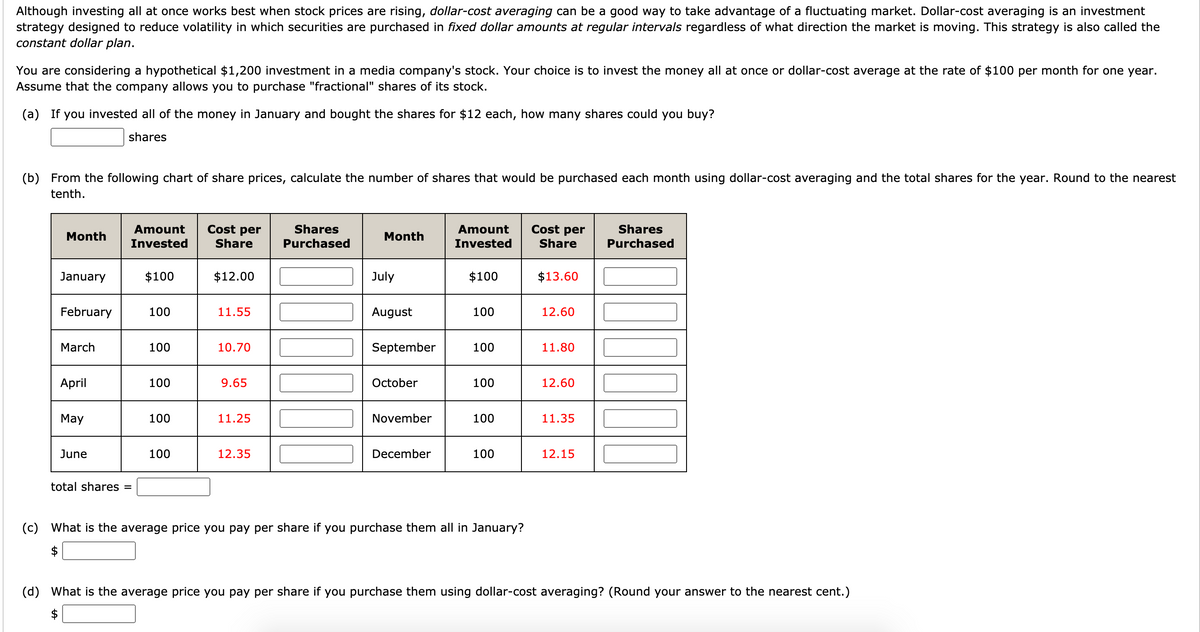Although investing all at once works best when stock prices are rising, dollar-cost averaging can be a good way to take advantage of a fluctuating market. Dollar-cost averaging is an investment strategy designed to reduce volatility in which securities are purchased in fixed dollar amounts at regular intervals regardless of what direction the market is moving. This strategy is also called the constant dollar plan. You are considering a hypothetical $1,200 investment in a media company's stock. Your choice is to invest the money all at once or dollar-cost average at the rate of $100 per month for one year. Assume that the company allows you to purchase "fractional" shares of its stock. (a) If you invested all of the money in January and bought the shares for $12 each, how many shares could you buy? shares (b) From the following chart of share prices, calculate the number of shares that would be purchased each month using dollar-cost averaging and the total shares for the year. Round to the nearest tenth. Cost per Share Amount Shares Amount Shares Cost per Share Month Month Invested Purchased Invested Purchased January $100 $12.00 July $100 $13.60 February 100 11.55 J August 100 12.60 March 100 10.70 September 100 11.80 April 100 9.65 October 100 12.60 May 100 11.25 November 100 11.35 June 100 12.35 December 100 12.15 total shares = (c) What is the average price you pay per share if you purchase them all in January? $4 (d) What is the average price you pay per share if you purchase them using dollar-cost averaging? (Round your answer to the nearest cent.) $
Although investing all at once works best when stock prices are rising, dollar-cost averaging can be a good way to take advantage of a fluctuating market. Dollar-cost averaging is an investment strategy designed to reduce volatility in which securities are purchased in fixed dollar amounts at regular intervals regardless of what direction the market is moving. This strategy is also called the constant dollar plan. You are considering a hypothetical $1,200 investment in a media company's stock. Your choice is to invest the money all at once or dollar-cost average at the rate of $100 per month for one year. Assume that the company allows you to purchase "fractional" shares of its stock. (a) If you invested all of the money in January and bought the shares for $12 each, how many shares could you buy? shares (b) From the following chart of share prices, calculate the number of shares that would be purchased each month using dollar-cost averaging and the total shares for the year. Round to the nearest tenth. Cost per Share Amount Shares Amount Shares Cost per Share Month Month Invested Purchased Invested Purchased January $100 $12.00 July $100 $13.60 February 100 11.55 J August 100 12.60 March 100 10.70 September 100 11.80 April 100 9.65 October 100 12.60 May 100 11.25 November 100 11.35 June 100 12.35 December 100 12.15 total shares = (c) What is the average price you pay per share if you purchase them all in January? $4 (d) What is the average price you pay per share if you purchase them using dollar-cost averaging? (Round your answer to the nearest cent.) $
Financial Management: Theory & Practice
16th Edition
ISBN:9781337909730
Author:Brigham
Publisher:Brigham
Chapter25: Portfolio Theory And Asset Pricing Models
Section: Chapter Questions
Problem 1MC
Related questions
Question
100%

Transcribed Image Text:Although investing all at once works best when stock prices are rising, dollar-cost averaging can be a good way to take advantage of a fluctuating market. Dollar-cost averaging is an investment
strategy designed to reduce volatility in which securities are purchased in fixed dollar amounts at regular intervals regardless of what direction the market is moving. This strategy is also called the
constant dollar plan.
You are considering a hypothetical $1,200 investment in a media company's stock. Your choice is to invest the money all at once or dollar-cost average at the rate of $100 per month for one year.
Assume that the company allows you to purchase "fractional" shares of its stock.
(a) If you invested all of the money in January and bought the shares for $12 each, how many shares could you buy?
shares
(b) From the following chart of share prices, calculate the number of shares that would be purchased each month using dollar-cost averaging and the total shares for the year. Round to the nearest
tenth.
Amount
Cost per
Shares
Amount
Cost per
Shares
Month
Month
Invested
Share
Purchased
Invested
Share
Purchased
January
$100
$12.00
July
$100
$13.60
February
100
11.55
August
100
12.60
March
100
10.70
September
100
11.80
April
100
9.65
October
100
12.60
Мay
100
11.25
November
100
11.35
June
100
12.35
December
100
12.15
total shares
(c) What is the average price you pay per share if you purchase them all in January?
$
(d) What is the average price you pay per share if you purchase them using dollar-cost averaging? (Round your answer to the nearest cent.)
Expert Solution
This question has been solved!
Explore an expertly crafted, step-by-step solution for a thorough understanding of key concepts.
This is a popular solution!
Trending now
This is a popular solution!
Step by step
Solved in 5 steps with 1 images

Knowledge Booster
Learn more about
Need a deep-dive on the concept behind this application? Look no further. Learn more about this topic, finance and related others by exploring similar questions and additional content below.Recommended textbooks for you


Intermediate Financial Management (MindTap Course…
Finance
ISBN:
9781337395083
Author:
Eugene F. Brigham, Phillip R. Daves
Publisher:
Cengage Learning

Financial Reporting, Financial Statement Analysis…
Finance
ISBN:
9781285190907
Author:
James M. Wahlen, Stephen P. Baginski, Mark Bradshaw
Publisher:
Cengage Learning


Intermediate Financial Management (MindTap Course…
Finance
ISBN:
9781337395083
Author:
Eugene F. Brigham, Phillip R. Daves
Publisher:
Cengage Learning

Financial Reporting, Financial Statement Analysis…
Finance
ISBN:
9781285190907
Author:
James M. Wahlen, Stephen P. Baginski, Mark Bradshaw
Publisher:
Cengage Learning
